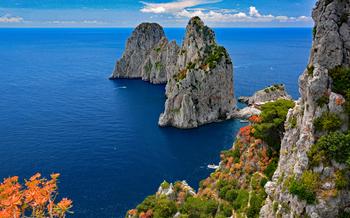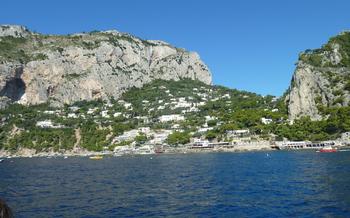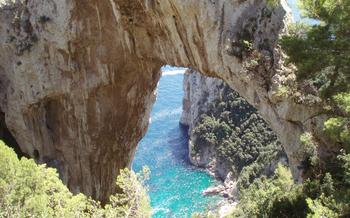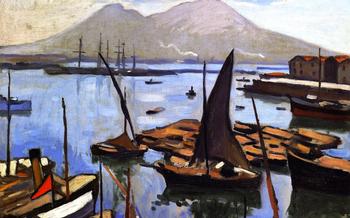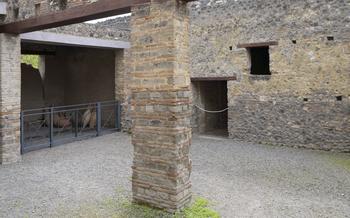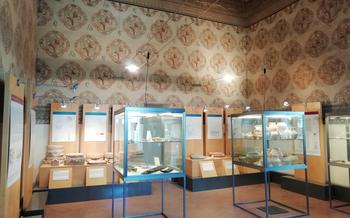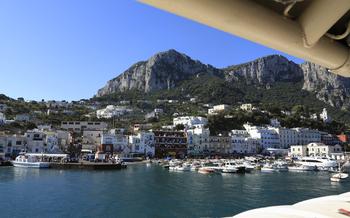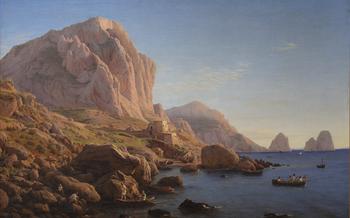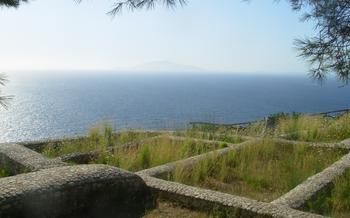
Villa Jovis
- Villa Jovis: A testament to Imperial Majesty and Exquisite Opulence
- Historical Context
- Location
- Architecture
- Mosaics and Frescoes: Artistic Masterpieces Adorning the Villa Jovis
- Gardens and Terraces
- Views and Panoramas
- Water Management System
- Imperial Apartments
- Administration and Governance
- Religious and Cultural Significance
- Restoration and Conservation Efforts
- Visiting the Villa Jovis
- Insider Tip
Villa Jovis: A testament to Imperial Majesty and Exquisite Opulence
Perched atop the dramatic cliffs of Capri, the Villa Jovis stands as a testament to the grandeur and opulence of the Roman Empire. Built by Emperor Tiberius in the 1st century AD, this luxurious retreat served as his private sanctuary, a place of serenity and power overlooking the azure waters of the Mediterranean Sea. Beyond its allure as an imperial residence, the villa also functioned as an administrative center, governing the island of Capri and showcasing the emperor's refined taste and strategic prowess. Its well-preserved ruins, adorned with intricate mosaics, frescoes, and sculptures, offer a glimpse into the lavish lifestyle and sophisticated architecture of the ancient world.
Historical Context
The Villa Jovis, perched majestically atop the eastern cliffs of Capri, holds a rich and storied history that dates back to the Roman era. In the year 27 AD, Emperor Tiberius, seeking refuge from the political turmoil of Rome, embarked on an ambitious project to construct a lavish retreat on this idyllic island. Over the next decade, skilled architects and artisans labored tirelessly to transform the rocky promontory into an architectural masterpiece.
As a testament to Tiberius' power and grandeur, the villa became a symbol of imperial authority. It served not only as a luxurious residence but also as an administrative center for governing the island of Capri. Within its opulent halls, the emperor conducted official business, received dignitaries, and hosted lavish banquets. The villa became a hub of political and social activity, reflecting Tiberius' desire to maintain control and influence from his island sanctuary.
However, with the fall of the Roman Empire, the villa's fortunes waned. Abandoned and neglected, it fell into ruin, its once-vibrant mosaics fading and its elegant frescoes crumbling. Over time, the villa became shrouded in mystery and legend, its former glory obscured by the passage of centuries.
Location
The Villa Jovis is strategically nestled on the westernmost tip of the island of Capri, offering unparalleled views of the Mediterranean Sea. Its elevated position ensures a commanding presence, overlooking the picturesque towns of Anacapri and Capri. The villa's strategic placement allowed Emperor Tiberius to maintain control over the island, while also enjoying the stunning vistas and seclusion that the location provided.
Reaching the Villa Jovis is a breeze. Visitors can opt to take a scenic bus ride from Anacapri or Capri, which offers breathtaking views along the way. The villa is also accessible by private vehicle, following the winding roads that lead up to its majestic entrance. Whether arriving by public transportation or private car, the journey to the Villa Jovis is an adventure in itself, setting the stage for an unforgettable exploration of this ancient imperial retreat.
Architecture
The architectural style of Villa Jovis is a unique blend of Roman elegance and Hellenistic influences. Constructed using local materials such as limestone and tuff, the villa seamlessly integrates with the natural surroundings. It can be divided into several distinct sections, each showcasing the diverse functions of this palatial estate.
The imperial apartments, reserved for Emperor Tiberius and his entourage, boast opulent decorations and luxurious amenities, reflecting the imperial power and splendor. These private spaces include lavish bedrooms, dining rooms, and reception halls adorned with frescoes, mosaics, and marble sculptures. The intricate details and sumptuous furnishings speak volumes about the grandeur and extravagance of imperial life.
The baths, an integral part of Roman culture, are a highlight of the villa. The complex features separate sections for hot (caldarium), warm (tepidarium), and cold (frigidarium) baths. Sophisticated engineering allowed for the efficient circulation of thermal water from natural springs, providing therapeutic benefits and relaxation to the villa's inhabitants.
The cisterns, essential for water storage, showcase the villa's advanced water management system. These underground reservoirs collected and stored rainwater, ensuring a consistent water supply for daily use and irrigation of the lush gardens. The strategic placement of the cisterns and the use of waterproof materials demonstrate the Romans' mastery of hydraulic engineering.
The villa's architecture is not merely functional but also aesthetically pleasing. The harmonious balance between form and function creates a visually stunning masterpiece. The use of arches, vaulted ceilings, and intricate decorative elements adds elegance and grandeur to the entire complex, making it an architectural marvel that stands the test of time.
Mosaics and Frescoes: Artistic Masterpieces Adorning the Villa Jovis
The Villa Jovis is adorned with exquisite mosaics and frescoes that showcase the artistic prowess of the Roman era. These artworks, created by skilled artisans, tell stories, depict mythological scenes, and bring life to the villa's walls and floors.
The mosaics, composed of tiny colored tiles, adorn the floors of various rooms, creating intricate patterns and captivating scenes. Geometric designs, floral motifs, and marine creatures are just a few of the subjects depicted in these mosaics. The intricate details and vivid colors add a touch of grandeur and opulence to the villa's interiors.
The frescoes, painted directly onto the walls, depict a wide range of subjects, from landscapes and still lifes to mythological scenes and portraits of Roman emperors. The vibrant colors and lifelike figures seem to jump off the walls, creating a sense of depth and realism. Among the most notable frescoes is a depiction of Bacchus, the Roman god of wine, riding on a chariot pulled by leopards.
The techniques used to create these mosaics and frescoes are a testament to the skill and artistry of the Roman craftsmen. The mosaics are made from small tesserae, or tiles, which are cut and arranged to form intricate patterns and images. The frescoes, on the other hand, are created using a variety of pigments mixed with water and applied directly to the wall surface.
Over the centuries, these artistic masterpieces have been subjected to the ravages of time and natural elements. However, thanks to careful restoration and conservation efforts, they have been preserved and continue to captivate visitors with their beauty and historical significance.
Gardens and Terraces
The Villa Jovis boasts lush gardens and terraces that exquisitely complement the architectural grandeur of the estate. These verdant spaces, meticulously designed to enhance the visual allure of the villa, provide a serene sanctuary for relaxation and contemplation. Visitors can stroll through the gardens, immersing themselves in the aromatic fragrance of blooming flowers and the vibrant colors of exotic plants.
The gardens showcase a diverse array of Mediterranean flora, including fragrant citrus trees, colorful bougainvillea, and delicate jasmine vines. These botanical wonders, thriving under the warm Mediterranean sun, create a mesmerizing tapestry of colors and textures. The terraces, offering panoramic views of the sparkling sea and the rugged coastline, provide the perfect vantage point to soak in the breathtaking beauty of the natural surroundings.
These outdoor spaces were not merely ornamental but also served a practical purpose, providing shade and respite from the intense summer heat. The gardens were carefully designed to maximize natural ventilation, creating a refreshing and comfortable microclimate within the villa. The terraces, with their strategic positioning and elevated views, allowed the inhabitants to enjoy the cooling sea breezes and take in the picturesque vistas of the Mediterranean landscape.
Views and Panoramas
Villa Jovis boasts some of the most breathtaking views in all of Italy. Perched high on the cliffs of Capri, the villa offers unparalleled vistas of the Mediterranean Sea, the rugged coastline, and the picturesque towns below. From the villa's terraces and windows, visitors can gaze out at the sparkling blue waters, the lush green hills, and the distant islands.
The strategic positioning of the villa allows visitors to enjoy panoramic views from every angle. The main terrace, known as the Belvedere, offers an unobstructed view of the sea, where visitors can watch boats sail by and admire the stunning sunsets. From the eastern terrace, visitors can enjoy views of the neighboring island of Ischia and the Gulf of Naples.
The gardens surrounding the villa are another great spot to soak in the scenery. While strolling through the lush greenery, visitors can pause to admire the panoramic views that unfold before them. Whether it's from the villa's terraces, windows, or gardens, the views from Villa Jovis are simply unforgettable.
Water Management System
The Villa Jovis boasts an impressive water management system that ensured a continuous supply of fresh water to its inhabitants. The Romans, renowned for their engineering prowess, constructed aqueducts that channeled water from distant springs and streams to the villa's reservoirs. These aqueducts were meticulously engineered to maintain a steady flow of water, even during periods of drought. Within the villa, a network of underground pipes and channels distributed water to various parts of the complex, including the baths, kitchens, and gardens.
To supplement the water supply, the villa also relied on rainwater harvesting. An intricate system of gutters and cisterns collected and stored rainwater for future use. These cisterns were strategically placed throughout the villa, ensuring that water was easily accessible during the dry season. The Romans' innovative water management system not only provided essential resources for the villa's inhabitants but also showcased their commitment to sustainable living and efficient resource allocation.
The water management system of the Villa Jovis stands as a testament to the Romans' ingenuity and their ability to adapt to the challenges of their environment. By harnessing the power of nature and implementing advanced engineering techniques, they created a self-sufficient water supply that sustained the luxurious lifestyle of the villa's occupants. Even today, the remains of this sophisticated system continue to inspire admiration and serve as a reminder of the Romans' enduring legacy.
Imperial Apartments
The Imperial Apartments at the Villa Jovis were designed to provide Emperor Tiberius with the ultimate in comfort, luxury, and privacy. These opulent living quarters were adorned with intricate mosaics, frescoes, and marble sculptures, showcasing the finest craftsmanship of the Roman Empire. Tiberius' private chambers consisted of a spacious bedroom, a lavish dining room, and a reception hall for entertaining guests. The apartments also featured a private garden, where the emperor could relax and enjoy the tranquil surroundings. The Imperial Apartments served as the center of Tiberius' power and influence, reflecting his status as the ruler of the Roman Empire.
Administration and Governance
The Villa Jovis served not only as a lavish retreat but also as an important center for administering the island of Capri. Tiberius, as the emperor, conducted official business and exercised his power from this opulent setting. The villa housed administrative offices, meeting rooms, and reception halls, where officials, dignitaries, and representatives from various parts of the island gathered to discuss matters of governance, taxation, and justice. It was here that Tiberius made decisions that affected the daily lives and well-being of the island's inhabitants. The villa's strategic location on the island allowed for easy access and communication with the mainland, ensuring that Capri remained well-connected and under the emperor's direct control.
Religious and Cultural Significance
Beyond its political and administrative functions, the Villa Jovis held significant religious and cultural importance. Shrines and altars dedicated to Roman deities, such as Jupiter, Juno, and Minerva, were found within the villa's sacred spaces. These religious sanctuaries provided a place for the imperial family and the villa's inhabitants to pay homage and seek divine favor.
Furthermore, the villa served as a venue for various cultural events, performances, and celebrations. The presence of a large theater indicates that theatrical productions, musical performances, and recitals were likely held within the villa's grounds. These cultural activities provided entertainment and intellectual stimulation for the imperial court and the villa's guests.
Archaeological excavations at the Villa Jovis have unearthed a wealth of artifacts, including sculptures, inscriptions, and mosaics, which shed light on the religious and cultural practices of the Roman elite. These discoveries offer valuable insights into the beliefs, rituals, and artistic expressions of ancient Roman society.
The religious and cultural significance of the Villa Jovis adds another layer to its historical and architectural importance, making it a fascinating site for visitors interested in exploring the multifaceted legacy of the Roman Empire.
Restoration and Conservation Efforts
Over the centuries, the Villa Jovis faced numerous challenges, including natural disasters, looting, and neglect. In the 19th century, the villa underwent its first major restoration, which focused on stabilizing the structures and excavating buried sections. However, it was not until the mid-20th century that a comprehensive restoration project was initiated.
This ambitious undertaking involved meticulous restoration of the villa's architectural features, mosaics, and frescoes. Skilled artisans employed traditional techniques to repair and reconstruct damaged elements, using materials similar to those used in ancient times. The project also included extensive archaeological excavations, which unearthed valuable artifacts and provided insights into the villa's history.
Ongoing maintenance and research are essential to ensure the long-term preservation of the Villa Jovis. Regular monitoring of the site helps identify and address potential threats, such as structural instability, erosion, and vandalism. Conservation efforts also focus on preserving the villa's unique artistic and historical features, ensuring that future generations can continue to appreciate this remarkable monument.
The restoration and conservation of the Villa Jovis is a testament to the enduring legacy of ancient Roman architecture and the dedication of experts committed to preserving this cultural treasure for generations to come.
Visiting the Villa Jovis
Visiting the Villa Jovis is an enriching experience that offers a glimpse into the life and reign of Emperor Tiberius. The villa is open to the public daily from 9 am to 6 pm, with guided tours available in various languages. Admission fees are reasonable, and discounts are offered to students, seniors, and families.
To make the most of your visit, plan to spend at least an hour exploring the villa's many sections. Guided tours are highly recommended as they provide insightful commentary on the villa's history, architecture, and unique features. It's advisable to book your tour in advance, especially during peak tourist season, to avoid disappointment.
While exploring the villa, don't miss the opportunity to enjoy the breathtaking views from its terraces and windows. The panoramic vistas of the Mediterranean Sea, the rugged coastline, and the lush greenery of the island are simply mesmerizing. Be sure to have your camera ready to capture these unforgettable moments.
After your visit to the Villa Jovis, consider exploring other nearby attractions that Capri offers. The Blue Grotto, a stunning sea cave with mesmerizing blue waters, is a must-see. The Gardens of Augustus, with its enchanting flora and scenic views, is also worth a visit.
To fully immerse yourself in the Italian experience, savor a delicious meal at a local restaurant after your visit. The island is renowned for its fresh seafood, homemade pasta, and delectable desserts. Indulge in the local cuisine and enjoy the warm hospitality of the Capri locals to complete your unforgettable journey.
Insider Tip
Venture beyond the main tourist routes and discover hidden gems within the Villa Jovis. Seek out the secluded Belvedere delle Sirene, a terrace perched on the cliff's edge, offering unparalleled panoramic views of the Faraglioni rock formations and the endless expanse of the Mediterranean Sea. Capture breathtaking photographs that will forever immortalize the beauty of Capri and its surroundings.
After immersing yourself in the history and splendor of the Villa Jovis, enhance your Capri experience by exploring other nearby attractions. Indulge in a refreshing dip in the crystal-clear waters of the Blue Grotto, a natural sea cave renowned for its mesmerizing blue light. Stroll through the verdant Gardens of Augustus, a botanical paradise overlooking the sea, and admire the diverse collection of exotic plants and flowers.
Conclude your Capri adventure with a culinary delight at one of the local restaurants or cafes. Savor authentic Italian cuisine, crafted with fresh local ingredients, while basking in the enchanting ambiance of this picturesque island.
